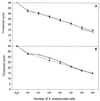Quantitative detection of Streptococcus pneumoniae in nasopharyngeal secretions by real-time PCR
- PMID: 11526140
- PMCID: PMC88308
- DOI: 10.1128/JCM.39.9.3129-3134.2001
Quantitative detection of Streptococcus pneumoniae in nasopharyngeal secretions by real-time PCR
Abstract
Streptococcus pneumoniae is an important cause of community-acquired pneumonia. However, in this setting the diagnostic sensitivity of blood cultures is below 30%. Since during such infections changes in the amounts of S. pneumoniae may also occur in the upper respiratory tract, quantification of these bacteria in nasopharnygeal secretions (NPSs) may offer a suitable diagnostic approach. Real-time PCR offers a sensitive, efficient, and routinely reproducible approach to quantification. Using primers and a fluorescent probe specific for the pneumolysin gene, we were able to detect DNA from serial dilutions of S. pneumoniae cells in which the quantities of DNA ranged from the amounts extracted from 1 to 10(6) cells. No difference was noted when the same DNA was mixed with DNA extracted from NPSs shown to be deficient of S. pneumoniae following culture, suggesting that this bacterium can be detected and accurately quantitated in clinical samples. DNAs from Haemophilus influenzae, Moraxella catarrhalis, or alpha-hemolytic streptococci other than S. pneumoniae were not amplified or were only weakly amplified when there were > or =10(6) cells per reaction mixture. When the assay was applied to NPSs from patients with respiratory tract infections, the assay performed with a sensitivity of 100% and a specificity of up to 96% compared to the culture results. The numbers of S. pneumoniae organisms detected by real-time PCR correlated with the numbers detected by semiquantitative cultures. A real-time PCR that targeted the pneumolysin gene provided a sensitive and reliable means for routine rapid detection and quantification of S. pneumoniae present in NPSs. This assay may serve as a tool to study changes in the amounts of S. pneumoniae during lower respiratory tract infections.
Figures





References
-
- Chalasani N P, Valdecanas M A, Gopal A K, McGowan J E, Jurado R L. Clinical utility of blood cultures in adult patients with community-acquired pneumonia without defined underlying risks. Chest. 1995;108:932–936. - PubMed
-
- Fischer-Romero C, Luthy-Hottenstein J, Altwegg M. Development and evaluation of a broad-range PCR-ELISA assay with Borrelia burgdorferi and Streptococcus pneumoniae as model organisms for reactive arthritis and bacterial meningitis. J Microbiol Methods. 2000;40:79–88. - PubMed
-
- Goldenberg D L. Septic arthritis. Lancet. 1998;351:197–202. - PubMed
Publication types
MeSH terms
Substances
LinkOut - more resources
Full Text Sources
Other Literature Sources
Medical
Molecular Biology Databases

